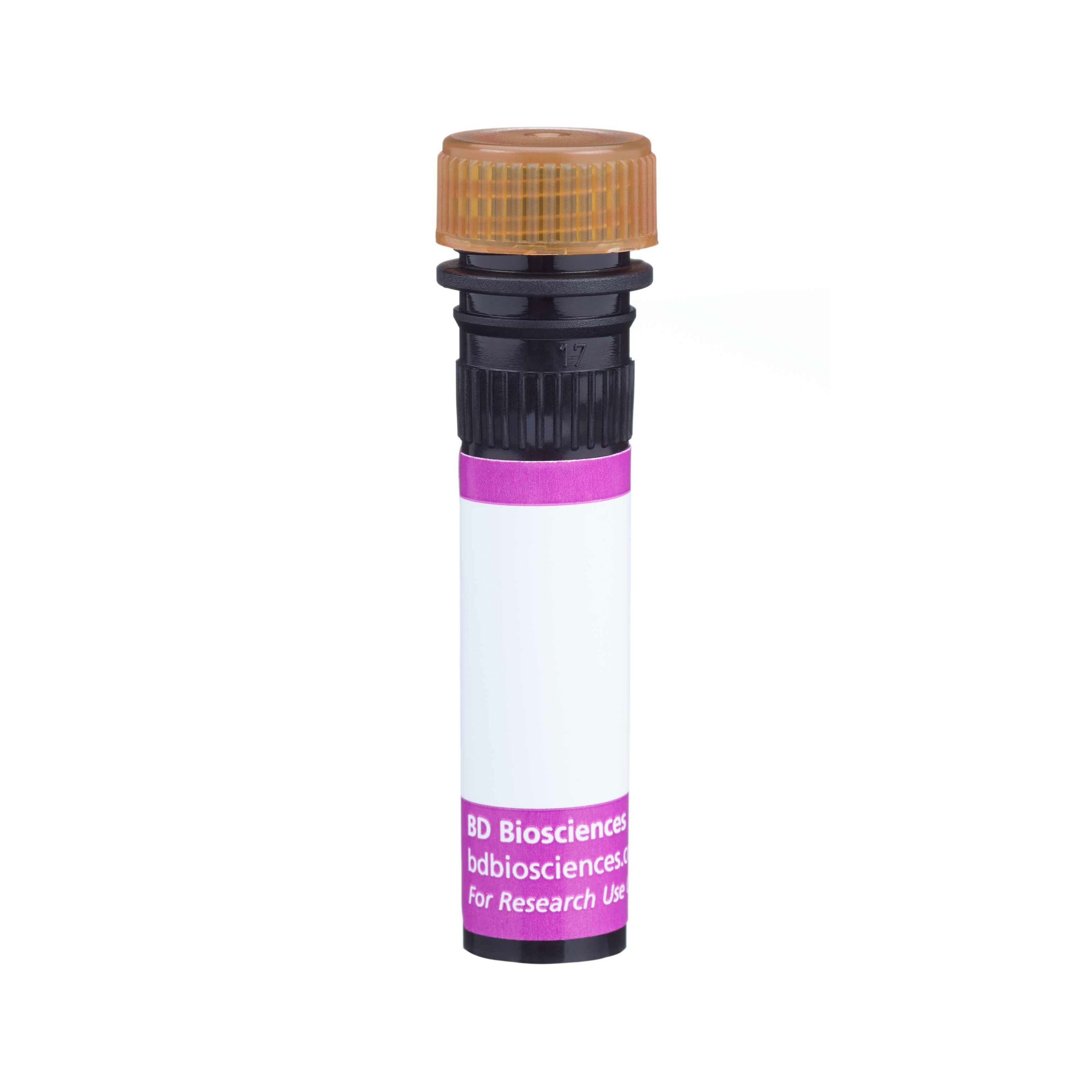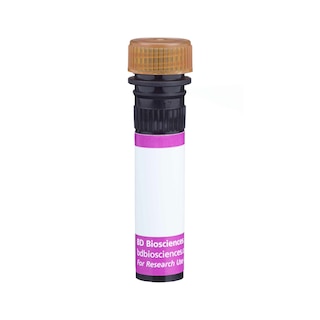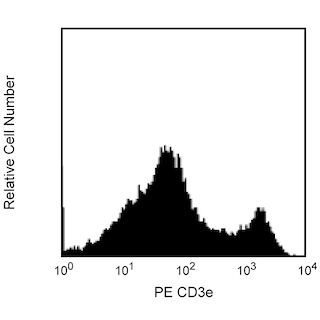Old Browser
Looks like you're visiting us from {countryName}.
Would you like to stay on the current country site or be switched to your country?




Two-color flow cytometric analysis of CD103 expression on mouse lymph node cells. Mouse lymph node cells were preincubated with Purified Rat Anti-Mouse CD16/CD32 antibody (Mouse BD Fc Block™) (Cat. No. 553141/553142). The cells were then stained with PE Hamster Anti-Mouse CD3e antibody (Cat. No. 553064/553063/561824) and either BD Horizon™ BV786 Rat IgG2a, κ Isotype Control (Cat. No. 563335; Left Panel) or BD Horizon BV786 Rat Anti-Mouse CD103 antibody (Cat. No. 564322; Right Panel). Two-color contour plots showing the coexpression patterns of CD103 (or Ig Isotype Control staining) versus CD3e were derived from gated events with the forward and side light-scatter characteristics of viable leucocytes. Flow cytometric analysis was performed using a BD™ LSR II Flow Cytometer System.


BD Horizon™ BV786 Rat Anti-Mouse CD103

Regulatory Status Legend
Any use of products other than the permitted use without the express written authorization of Becton, Dickinson and Company is strictly prohibited.
Preparation And Storage
Recommended Assay Procedures
For optimal and reproducible results, BD Horizon Brilliant™ Stain Buffer should be used anytime BD Horizon Brilliant™ dyes are used in a multicolor flow cytometry panel. Fluorescent dye interactions may cause staining artifacts which may affect data interpretation. The BD Horizon Brilliant Stain Buffer was designed to minimize these interactions. When BD Horizon Brilliant Stain Buffer is used in in the multicolor panel, it should also be used in the corresponding compensation controls for all dyes to achieve the most accurate compensation. For the most accurate compensation, compensation controls created with either cells or beads should be exposed to BD Horizon Brilliant Stain Buffer for the same length of time as the corresponding multicolor panel. More information can be found in the Technical Data Sheet of the BD Horizon Brilliant Stain Buffer (Cat. No. 563794/566349) or the BD Horizon Brilliant Stain Buffer Plus (Cat. No. 566385).
Product Notices
- Since applications vary, each investigator should titrate the reagent to obtain optimal results.
- An isotype control should be used at the same concentration as the antibody of interest.
- Caution: Sodium azide yields highly toxic hydrazoic acid under acidic conditions. Dilute azide compounds in running water before discarding to avoid accumulation of potentially explosive deposits in plumbing.
- Source of all serum proteins is from USDA inspected abattoirs located in the United States.
- For fluorochrome spectra and suitable instrument settings, please refer to our Multicolor Flow Cytometry web page at www.bdbiosciences.com/colors.
- Cy is a trademark of GE Healthcare.
- BD Horizon Brilliant Stain Buffer is covered by one or more of the following US patents: 8,110,673; 8,158,444; 8,575,303; 8,354,239.
- BD Horizon Brilliant Violet 786 is covered by one or more of the following US patents: 8,110,673; 8,158,444; 8,227,187; 8,455,613; 8,575,303; 8,354,239.
- Please refer to www.bdbiosciences.com/us/s/resources for technical protocols.
Companion Products






The M290 antibody specificaly binds to CD103, the α chain of αIELβ7 integrin. CD103 has a unique and fairly restricted tissue distribution. It is expressed on almost all intestinal intraepithelial lymphocytes (IEL), dendritic epidermal T cells (DEC), subpopulations of peripheral T cells, and distinct subsets of fetal, neonatal, and adult thymocytes. E-cadherin is the epithelial cell ligand for αIELβ7 integrin. The ordered expression of αIEL during thymocyte development (which occurs under the influence of the thymic epithelium), high level of αIEL expression on peripheral T cells in epithelial tissues (IEL and DEC), and expression of CD103 on a subset of CD8+ lymphocytes responding to allogeneic epithelial cells, suggest that αIELβ7 integrin may have a common role in the interactions of T lymphocytes with epithelia during T-cell maturation and effector functions. CD103 is thought to play a role in allograft rejection. The M290 antibody is reported to efficiently inhibit αIELβ7-mediated adhesion in in vitro assays.

Development References (7)
-
Andrew DP, Rott LS, Kilshaw PJ, Butcher EC. Distribution of alpha 4 beta 7 and alpha E beta 7 integrins on thymocytes, intestinal epithelial lymphocytes and peripheral lymphocytes. Eur J Immunol. 1996; 26(4):897-905. (Clone-specific: Flow cytometry). View Reference
-
Feng Y, Wang D, Yuan R, Parker CM, Farber DL, Hadley GA. CD103 expression is required for destruction of pancreatic islet allografts by CD8(+) T cells. J Exp Med. 2002; 196(7):877-886. (Biology). View Reference
-
Hadley GA, Bartlett ST, Via CS, Rostapshova EA, Moainie S. The epithelial cell-specific integrin, CD103 (alpha E integrin), defines a novel subset of alloreactive CD8+ CTL. J Immunol. 1997; 159(8):748-3756. (Biology). View Reference
-
Karecla PI, Bowden SJ, Green SJ, Kilshaw PJ. Recognition of E-cadherin on epithelial cells by the mucosal T cell integrin alpha M290 beta 7 (alpha E beta 7). Eur J Immunol. 1995; 25(3):852-856. (Clone-specific: Blocking). View Reference
-
Kilshaw PJ, Baker KC. A unique surface antigen on intraepithelial lymphocytes in the mouse. Immunol Lett. 1988; 18(2):149-154. (Immunogen: Immunofluorescence, Immunohistochemistry, Immunoprecipitation). View Reference
-
Kilshaw PJ, Murant SJ. A new surface antigen on intraepithelial lymphocytes in the intestine. Eur J Immunol. 1990; 20(10):2201-2207. (Clone-specific: Immunoprecipitation). View Reference
-
Kilshaw PJ, Murant SJ. Expression and regulation of beta 7(beta p) integrins on mouse lymphocytes: relevance to the mucosal immune system. Eur J Immunol. 1991; 21(10):2591-2597. (Clone-specific: Immunohistochemistry). View Reference
Please refer to Support Documents for Quality Certificates
Global - Refer to manufacturer's instructions for use and related User Manuals and Technical data sheets before using this products as described
Comparisons, where applicable, are made against older BD Technology, manual methods or are general performance claims. Comparisons are not made against non-BD technologies, unless otherwise noted.
For Research Use Only. Not for use in diagnostic or therapeutic procedures.
Report a Site Issue
This form is intended to help us improve our website experience. For other support, please visit our Contact Us page.